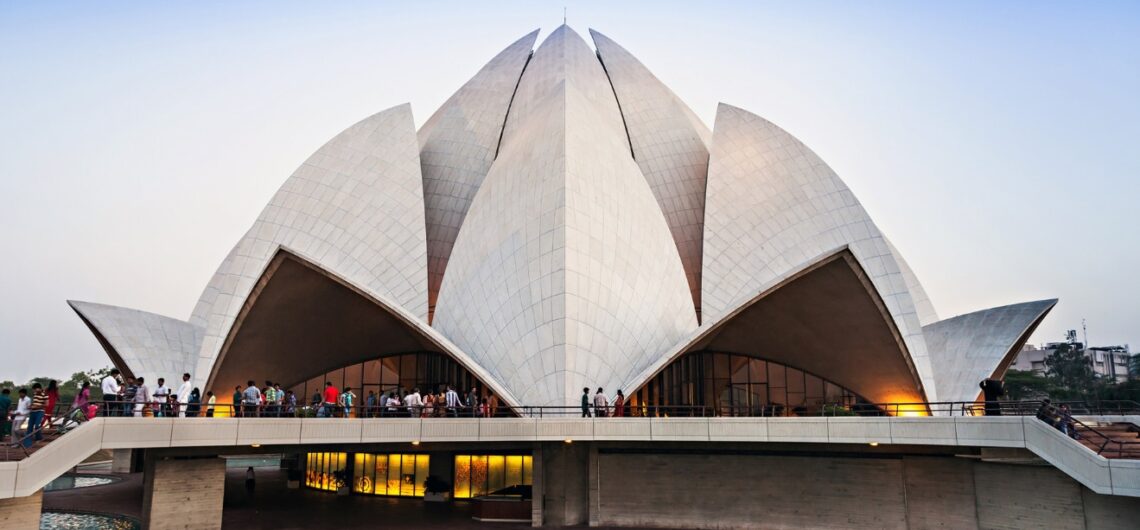
Introduction – Spirituality in Delhi
Spirituality in Delhi is a place where spirituality permeates daily life and is more than just the busy capital of India. Its bustling streets are lined with places of worship for all religions, including churches, mosques, gurudwaras, and temples. Each of these places provides a refuge for introspection, prayer, and community. We’ll travel to some of Delhi’s most recognizable houses of worship in this itinerary, highlighting the city’s extensive spiritual legacy.
Delhi’s Hindu Temples
Temple of Akshardham: A Contemporary Spiritual Wonder
One of Spirituality in Delhi most visited sights is the magnificent architectural marvel known as the Akshardham Temple. It honors Bhagwan Swaminarayan and was inaugurated in 2005. With its elaborately carved pillars, domes, and statues, it is a representation of traditional Indian architecture. Beyond merely providing a spiritual experience, Akshardham’s cultural displays, light and sound performance, and lovely grounds make it an essential destination for anybody looking for inspiration and serenity.
Lotus Temple: A Sign of Harmony and Calm
Shaped like a lotus flower, the Lotus Temple is a Bahá’í House of Worship that is well-known for its magnificent architecture. It is accessible to people of all faiths, represents harmony, and offers a tranquil haven from the hectic pace of the city. It’s the ideal place for reflection and meditation because of the calm atmosphere and beautiful surroundings.
Spirituality in Spirituality in Delhi Temple of Hanuman, Connaught Place
Located close to Connaught Place in the central region of Delhi, this historic temple honors Lord Hanuman. It is regarded as one of the five temples from the Mahabharata period and draws devotees who are looking for spiritual power and benefits. Tuesdays are very busy at the Hanuman Temple because it is Lord Hanuman’s day.
Temple of Kalka Ji: A Respected Shakti Peeth
One of India’s most venerated Shakti temples, Kalka Ji Temple is situated close to Nehru Place. This shrine is devoted to Goddess Kali and holds great spiritual significance for those who pray for protection and power. The temple attracts pilgrims from all around India during the Navratri holiday, when it is very active.
Delhi’s Islamic Spirituality
India’s Largest Mosque, Jama Masjid
Jama Masjid, erected in 1656 by the Mughal Emperor Shah Jahan, is a magnificent example of Mughal architecture. With a capacity of 25,000 people, it is the biggest mosque in India. As soon as they go inside, the expansive courtyard, soaring minarets, and exquisitely decorated domes can evoke awe in visitors. In addition to being a place of worship, its southern minaret provides breathtaking views over Old Delhi.
Hazrat Nizamuddin Dargah: A Site for Sufi Site Worship
One of the most respected Sufi saints, Hazrat Nizamuddin Auliya, has a haven of spiritual consolation called the Dargah. This dargah, which is near Nizamuddin, draws followers of all religions because of its daily performances of soul-stirring qawwalis (devotional music). The dargah attracts both domestic and foreign tourists since it is a representation of love, peace, and Spirituality in Delhi.
Fatehpuri Mosque: An Overview of Mughal Buildings
Built around 1650 by Fatehpuri Begum, one of Shah Jahan’s wives, Fatehpuri Masjid is located at the western end of Chandni Chowk. For individuals who are interested in Islamic history and Mughal design, the mosque is a more sedate option than Jama Masjid. The mosque continues to serve as a hub for community events and Islamic education.
Delhi’s Christian Churches
Cathedral of Sacred Heart: The Ancient Catholic Church
Near Connaught Place, the Sacred Heart Cathedral is one of Spirituality in Delhi biggest and oldest cathedrals. This 1930-built Catholic church combines colonial and Italian architectural elements. It’s a calm location to worship because of the serene surroundings and exquisitely crafted interior, especially during mass and Christmas celebrations.
St. James’ Church: An Icon of the Colonial Era
Colonel James Skinner constructed the stunning St. James’ Church near Kashmere Gate in 1836. Reminiscent of Spirituality in Delhi colonial past is the church with its unusual yellow exterior. It is a unique location for individuals looking to connect spiritually in a historical context because of its historical relevance and calm interior.
The Redemption Cathedral: An Icon of British Architecture
The Cathedral Church of the Redemption is a famous Anglican church that situated near Rashtrapati Bhavan. Built in the British era, it represents the impact of British architecture in India. A serene area for prayer and contemplation is provided by the church’s very modest yet attractive decor and serene grounds.
Spirituality in Delhi Sikh community
The Gurudwara Bangla Sahib is a peaceful and contemplative place.
In Delhi, one of the most well-known Sikh shrines is Gurudwara Bangla Sahib. Renowned for its magnificent golden dome and serene sarovar (pond), this gurudwara serves as both a place of service and a place of spiritual refuge. Thousands of people are fed every day by the community kitchen, or langar, regardless of their ethnicity or religion. Here, guests can feel the warmth and devotion of Sikh hospitality.
Sis Ganj Sahib Gurudwara: Paying Tribute to Sikh Martyrs
The ninth Sikh Guru, Guru Tegh Bahadur, was slain at the place marked by Gurudwara Sis Ganj Sahib, which is situated near Chandni Chowk. The gurudwara is a representation of bravery, devotion, and selflessness. Many people visit there in order to pay their respects and feel a connection to the spiritual legacy of the Sikh Gurus.
Delhi’s Jain Temples
The spiritual center of Old Delhi is Sri Digambar Jain Lal Mandir.
One of Delhi’s oldest Jain temples is Sri Digambar Jain Lal Mandir, which is located across from the Red Fort. It is well known for the calm ambiance and eye-catching crimson facade. In addition to being devoted to Lord Mahavira, the 24th Tirthankara in Jainism, the temple has a bird hospital, which symbolizes the religion’s profound regard for all living things.
A temple devoted to non-violence, Ahinsa Sthal
Situated on the Mehrauli-Gurgaon Road, Ahinsa Sthal is a well-known Jain temple that upholds the ideal of non-violence. It has a sizable statue of Lord Mahavira and provides a serene setting for introspection and meditation on Jain principles.
Meditation centers and spiritual retreats
The Ashram Way of Life
The Art of Living Ashram, which is situated outside of Spirituality in Delhi, provides comprehensive wellness, yoga, and meditation retreats. For those looking for serenity and spiritual development amid the bustle of the city, it’s a terrific place to be. The center offers a range of mindfulness and stress management classes.
The ISKCON Temple’s Meditation Initiatives
In addition to being a site of worship, the ISKCON Temple east of Kailash serves as a gathering place for spiritual pursuits like yoga, meditation, and kirtans, or devotional singing. These events offer opportunities for visitors to learn about Lord Krishna’s teachings and to establish a connection with their inner selves.
Delhi’s Multifaith Experience
Harmony among Diversities: Festivities and Gatherings
Festivals like Diwali, Eid, Christmas, and Guru Nanak Jayanti are all celebrated with equal zeal in Delhi, a melting pot of cultures and religions. These celebrations offer a singular chance to witness the spiritual diversity of the city and the peaceful coexistence of various religions.
Delhi’s Religious Peace and Cohabitation
The religious concord of Delhi is among its most notable features. People of different faiths coexist together and worship in the city. The near proximity of mosques, churches, gurudwaras, and temples represents the spirit of harmony and cohabitation that characterizes Delhi.
In summary
The Spirituality in Delhi is as varied as its past. There are many different spiritual experiences available in the city, ranging from contemporary meditation facilities to historic temples. Delhi has something to offer everyone, whether they are looking for the serenity and quiet of a meditation retreat, the devotion of a temple, or the comfort of a peaceful church.
FAQ 1. Which Delhi Hindu temple is the most well-known?
One of the most well-known Hindu temples in Delhi, the Akshardham Temple is renowned for both its elaborate design and its deep spiritual meaning.
2. When is the ideal time to go to the mosque?
When there are few people and nice weather, it’s ideal to visit Jama Masjid in the early morning or late afternoon.
3. In Delhi, where may I encounter Sikh spirituality?
Two of the most well-known locations in Delhi to encounter Sikh spirituality are Gurudwara Bangla Sahib and Gurudwara Sis Ganj Sahib.
4. Do spiritual retreats and meditation centers exist in Delhi?
Yes, spiritual retreats and meditation classes are provided by organizations like The Art of Living Ashram and ISKCON Temple.
5. In what ways does Delhi foster religious concord?
Delhi’s varied spiritual environment, where followers of various faiths live in concord and celebrate each other’s holidays, fosters religious unity.
6. Which Hindu temple in Delhi has the most reputation?
The Akshardham Temple, one of the most well-known Hindu temples in Delhi, is well-known for both its intricate architecture and its profound spiritual significance.
7. What time of day is best to visit the mosque?
It is best to visit Jama Masjid early in the morning or late in the afternoon when there aren’t many people around and the weather is pleasant.
8. Where can I find Sikh spirituality in Delhi?
There are two prominent places in Delhi where one can experience Sikh spirituality: Gurudwara Bangla Sahib and Gurudwara Sis Ganj Sahib.
9. Are there meditation institutes and spiritual retreats in Delhi?
Yes, institutions like the ISKCON Temple and The Art of Living Ashram provide meditation courses and spiritual retreats.
10. How does Delhi promote religious harmony?
Religious unity is fostered by Delhi’s diverse spiritual environment, where adherents of different religions coexist peacefully and celebrate one other’s holidays.


Comments